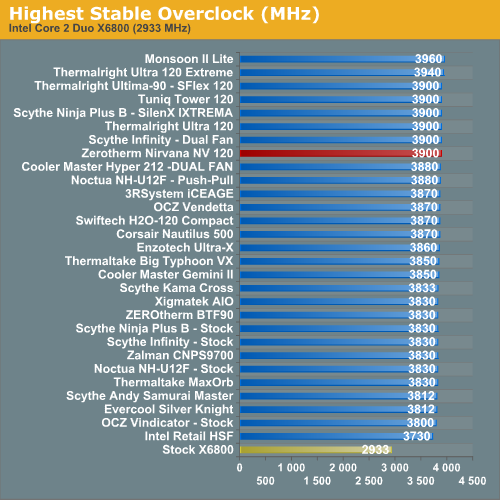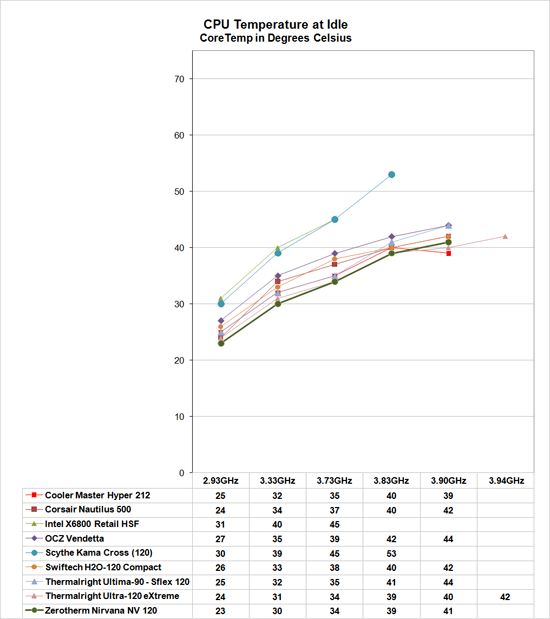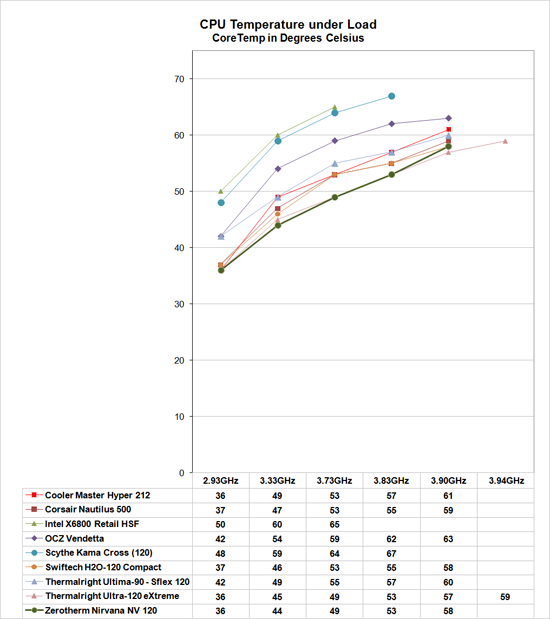ZEROtherm Nirvana: Designed for Top Performance
by Wesley Fink on January 16, 2008 5:00 PM EST- Posted in
- Cases/Cooling/PSUs
Overclocking and Performance Scaling
With outstanding performance at stock speed, we pushed the ZEROtherm Nirvana in our performance scaling tests to see if this air cooler delivers similarly impressive performance when pushed hard in overclocking. As cooling solutions do a better job of keeping the CPU at a lower temperature, it is reasonable to expect the overclocking capabilities of the CPU will increase as cooler performance increases. In each test of a cooler, we measure the highest stable overclock of a standard X6800 processor under the following conditions:
CPU
Multiplier: 11x (Stock 11x)
CPU Strap: 266 (stock) or 333 (overclocked)
CPU voltage: 1.5875V at Max overclock
NB Voltage: 1.70V
FSB Voltage: 1.40V
SB Voltage: 1.20V
Memory is set to Auto timings on the P35. This removes memory as any kind of impediment to the maximum stable overclock. As FSB is raised the linked memory speed increases in proportion. For this reason, we maintain memory speed as close as possible to CPU strap settings to prevent memory becoming an issue in CPU testing. This means 3.33GHz uses a 333 strap and runs 10x333, 3.73 uses a 333 strap and runs 11x339, and 3.90 GHz is a 333 strap and 354x11. The stock speed test is a 266 strap and 11x266. We may move in the future to a 3.0GHz stock speed with a 333 strap and 9x333 settings for complete consistency, but since we are not measuring raw computer performance in our cooling benchmarking this becomes a moot point. The same processor is used in all cooling tests to ensure comparable results.

The Nirvana lives up to its name in overclocking, reaching 3900 MHz with its single dedicated fan. This matches the top tier of cooler performance and is the match of other top coolers like the Thermalright Ultra-120 and the Tuniq Tower 120. However, the Nirvana was not stable above 3.9Ghz and it really did not challenge the Thermalright Ultra-120 eXtreme as the best performing air cooler tested so far at AnandTech. Still, this superb performance places the Nirvana among the very best air coolers you can buy for your system.
As stated many times, the overclocking abilities of CPUs will vary at the top, depending on the CPU. This particular CPU does higher FSB speeds than any X6800 we have tested, but the 3.9GHz top speed with the Thermalright Ultima-90 with 120mm fan is pretty average among the X6800 processors we have tested with top air cooling. A few of the other processors tested with the best air coolers reach just over 4 GHz, but the range has been 3.8 to 4.0GHz. Stock cooling generally tops out 200 to 400 MHz lower, depending on the CPU, on the processors tested in our lab.
Performance Scaling
Performance scaling charts for the ZEROtherm Nirvana use a scale with zero on the bottom and 75C on the top. Keep in mind that the lower line is the best performance in this presentation of the data - lower temperatures represent better performance.
 |
The Nirvana at idle is arguably the best performing cooler we have tested. Performance is better than or equal to the top Thermalright Ultra-120 eXtreme until the top speed of 3.90GHz is reached. The Thermalright is slightly better at 3.9Ghz and continues on to the highest overclock on air at 2.94GHz. This performance places the Nirvana solidly in the top cooler performance group with the Tuniq Tower, Scythe Infinity push-pull, Thermalright Ultra-120, and Thermalright Ultima-90 with 120mm fan.
Comparing cooling efficiency of the NV120 under load conditions to the retail HSF and other recently retested CPU coolers doesn't change the picture much. Load testing can be very revealing of a cooler's efficiency. A basically flat line, particularly form 3.73GHz upward, indicates the cooler is still in its best cooling range. A rapidly rising line indicates a cooler is nearing the end of its ability to cool efficiently. Lines that parallel the best coolers over a range of values show the coolers provide similar cooling performance.
 |
Under stress test conditions, the performance of the ZEROtherm Nirvana places it solidly in the top-performing cooler category. It is still outperformed by the leading Thermalright Ultra-120 eXtreme, but the Nirvana is definitely a performance match for any other top performing cooler we have tested.
There is no doubt, based on the test results, that the Nirvana is capable of dissipating 150W and possibly a bit more. This is outstanding performance for any cooler. However, based on the performance scaling it is clear that the Nirvana has reached its limit compared to other test results around 3.9GHz. It has no reserve to reach even higher as the Thermalright Ultra-120 eXtreme does. The reason for this may be as simple as the additional heat pipes of the Ultra-120 eXtreme.
Nirvana is clearly one of the best air coolers we have tested, and it deserves a slot as another choice among top-performing air coolers. At a selling price of around $45, the Nirvana competes very well for value in this top category. The Nirvana also comes standard with a fan controller at the $45 selling price, which will tip the scales toward this cooler for many users.










38 Comments
View All Comments
Wesley Fink - Thursday, January 17, 2008 - link
It looks like we are going to have to do an article to educate readers on dBa sound levels. Noise does matter, but some of the fanatic quiet sites have completely distorted the meaning of noise levels so people no longer understand what they mean. 35 dBa is the noise level of a quiet suburban bedroom, away from traffic, at night. 45 dBa is considered a Quiet Room. Our sound floor in the new test environment is around this level. Our super quiet variable-fan-speed power supply is around this level at idle, but not while doing useful work. Unless you are running a fanless power supply measurements below this threshold are meaningless.Below is a chart from an acoustic engineering company. It is to help put in perspective what dBa sound levels actually mean.
190 dBA Heavy weapons, 10 m behind the weapon (maximum level)
180 dBA Toy pistol fired close to ear (maximum level)
170 dBA Slap on the ear, fire cracker explodes on shoulder, small arms
at a distance of 50 cm (maximum level)
160 dBA Hammer stroke on brass tubing or steel plate at 1 m distance,
airbag deployment very close at a distance of 30 cm (maximum level)
150 dBA Hammer stroke in a smithy at 5 m distance (maximum level)
130 dBA Loud hand clapping at 1 m distance (maximum level)
120 dBA Whistle at 1 m distance, test run of a jet at 15 m distance
Threshold of pain, above this fast-acting hearing damage in short action is possible
115 dBA Take-off sound of planes at 10 m distance
110 dBA Siren at 10 m distance, frequent sound level in discotheques and close
to loudspeakers at rock concerts, violin close to the ear of an orchestra
musicians (maximum level)
105 dBA Chain saw at 1 m distance, banging car door at 1 m distance (maximum level),
racing car at 40 m distance, possible level with music head phones
100 dBA Frequent level with music via head phones, jack hammer at 10 m distance
95 dBA Loud crying, hand circular saw at 1 m distance
90 dBA Angle grinder outside at 1 m distance
Over a duration of 40 hours a week hearing damage is possible
85 dBA 2-stroke chain-saw at 10 m distance, loud WC flush at 1 m distance
80 dBA Very loud traffic noise of passing lorries at 7.5 m distance,
high traffic on an expressway at 25 m distance
75 dBA Passing car at 7.5 m distance, un-silenced wood shredder at 10 m distance
70 dBA Level close to a main road by day, quiet hair dryer at 1 m distance to ear
65 dBA Bad risk of heart circulation disease at constant impact
60 dBA Noisy lawn mower at 10 m distance
55 dBA Low volume of radio or TV at 1 m distance, noisy vacuum cleaner at
10 m distance
50 dBA Refrigerator at 1 m distance, bird twitter outside at 15 m distance
45 dBA Noise of normal living; talking, or radio in the background
40 dBA Distraction when learning or concentration possible
35 dBA Very quiet room fan at low speed at 1 m distance
25 dBA Sound of breathing at 1 m distance
0 dBA Auditory threshold
mustardman - Tuesday, January 22, 2008 - link
Doesn't the chart list 35dBa as a "Very quiet room fan at 1m"? That's quite different than a quiet suburban bedroom. Everyone's threshold of annoying noise is different. I know I can not sleep with a fan, even low speed, in my room. So, a computer louder than that is unacceptable. Same reason I had to unplug my TiVo before sleeping. I eventually moved it out of the room.I'll check the other sites in addition to Anand, which I've been an avid reader for 8+ years.
strikeback03 - Thursday, January 17, 2008 - link
I'd guess checking over at Silent PC Review would be more useful for you then, that is the type of testing they do. Anandtech has typically tried to show how it will impact a more typical system, which has fans.The room noise level for the tests was listed as 35dB, so a 25dB system would be probably be considered silent.
mustardman - Tuesday, January 22, 2008 - link
Good point. I didn't see the room noise level. I guess they would be unable to test lower in that case.Cardio - Thursday, January 17, 2008 - link
Have this cooler and improved its performance by 1-3c with a little work. Bottom of heatsink is chrome plated like the rest of the cooler. Chrome is a poor heat transfer material. I removed the chrome by sanding with 200 grit wet/dry @ 100RPM on a varible speed rotating bench sander. Finishing with jewelers rouge on a sheeps wool buffer. Bottom plate is also much smoother as it was quite shiny before but showed some machine marks. Very pleased with cooler as it now achieves great results at even lower fan speed.can - Monday, January 21, 2008 - link
It's nickel, not chrome.DukeN - Thursday, January 17, 2008 - link
Why not included in any comparisons guys - this one is incredibly popular (and seems like a great bargain at ~ $25 or less)?Thanks.
aussiestilgar - Thursday, January 17, 2008 - link
I've been waiting for AnandTech to review this cooler. I like that the test setup is very consistent which makes it easy to compare different coolers. I own this cooler and I must say its fantastic. It cools like the best of them and is extremely good value!sotx - Thursday, January 17, 2008 - link
um... just wondering here...the result for the ultra extreme 120 are obtained with or without the fan(s)?
Wesley Fink - Thursday, January 17, 2008 - link
The Thermalright Ultra-120 Extreme was tested with the Scythe SFlex SFF21F 120mm fan. You can refer to the full review for test results by clicking on the cooling tab at the top of this page and searching for the 120 eXtreme review.Those results were run with our earlier test bed and the nVidia utility and they are not directly comparable to current test results. As we said in the review we retested the top coolers on our new test bed with CoreTemp and those are the reported results in this review.